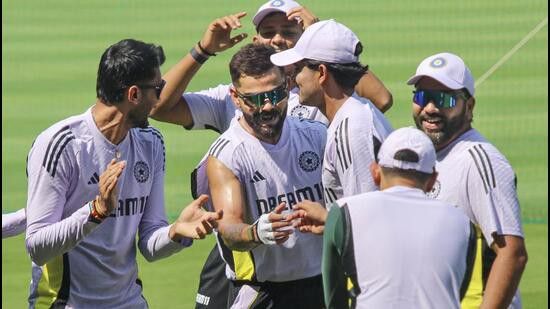
sanjeev
khelja|05-02-2025
Nagpur: Virat Kohli still walks to the crease with a swagger. But his records no longer have a halo around them. Four ordinary years out of the past five in Test cricket have taken a toll.
Amid this mediocrity in whites (avg 30.72 in 39 Tests), Kohli has held on to his stardom.
Having touched the peak of batting greatness in Tests before the dip, Kohli's continued allure is also a result of his consistency in limited overs cricket. In T20Is, he would successfully summon his big match temperament - take the 82* at MCG versus Pakistan in the 2022 T20 World Cup or 76 at Barbados against South Africa in the 2024 T20 World Cup final. However, if there is one out of the three main formats where Kohli still feels at home, it's good old ODI cricket.
On Tuesday, Kohli was the first to hit the nets in Nagpur before the England ODI series, batting in pairs with skipper Rohit Sharma, first facing pace, then spin. His demeanour during training, joking with the younger lot, wouldn't tell you but even his net sessions aren't as rhythmic as before. When Harshit Rana beat his outside edge, he would gesture to himself how the bounce was steeper than he anticipated. Last week, little-known Railways pacer Himanshu Sangwan went through his defence in the Ranji Trophy.
While Test cricket can be far more demanding technically, for someone like Kohli with tremendous success in white-ball cricket, ODIs can be a great platform. He will hope the next five weeks of 50-over cricket, starting with the three ODIs against England from Thursday followed by the Champions Trophy, help regain rhythm and confidence.
It's not just a question of Kohli's mastery of the format. It's technical too. Kohli belongs to a breed of all-format batters who changes his game very little while segueing from one format to the other. During the past five years, he has got the most runs, and an almost identical percentage of them, driving the ball.
But the returns have not been uniform.
It may be down to diminishing eyes, reflexes, age; his most productive stroke has also accounted for 32 out of his 38 dismissals against pace in Test cricket, behind the wicket -
caught behind or in the slip cordon. In white-ball cricket, such modes of dismissals become far less frequent - 6 out of 26 in ODIs and 5 out of 24 in T20Is.
While T20 poses other challenges like the need to use power or play unorthodox shots, ODIs allows Kohli to largely stick to his repertoire. The relentless lines of Scott Boland in Test cricket lose their edge with the softer Kookaburra white ball on batting-friendly decks and spell limits. After taming the new ball, Kohli rings in his signature flick (12% runs), pulls a lot more (15%) and introduces the less violent steer (8%) and rotates the strike (11%), using his oodles of energy to run briskly between the wickets.
The outcome has been chalk and cheese. Inhibited by off-stump problems against the red ball, where none of the technical tweaks worked - he tried a range of them in Australia, from taking off-stump guard, batting from the crease, outside it, standing front-on, side-on - his numbers in ODI cricket in the last five years (avg 51.04, 53 matches) have remained consistent.
Across his career, Kohli comes across as a beast of an ODI batter. His 13,906 runs (avg 58.18) are the most among contemporary batters. In the middle of his bad patch, when he showed up for the 2023 ODI World Cup, Kohli still finished as the tournament's top-scorer. Rohit Sharma's aggression as opener (highest tournament S/R 125) helped set it up for Kohli.
It was also the year when Kohli got runs in Tests too. If the batting stalwart wants to land more punches at the back end of his career, the Champions trophy should spur him on.
"We are now getting two quality players (Kohli and Rohit) back, who've got a phenomenal record in one-day cricket. Hopefully they can come in and deliver and probably try and be as aggressive and positive as they can," India coach Gautam Gambhir said last week.

3 Teams With Best Finishers In The ICC Champions Trophy 2025

Rashid Khan broke the world record and brought the team to the final, made a lot of failures in SA20

“Not Every Ball Is An Event…”: Kevin Pietersen Gives Verdict On Varun Chakravarthy’s Inclusion In ODI Squad

These 3 controversies spoiled the game of Prithvi Shaw, at a young age, he has come to retire at a young age






